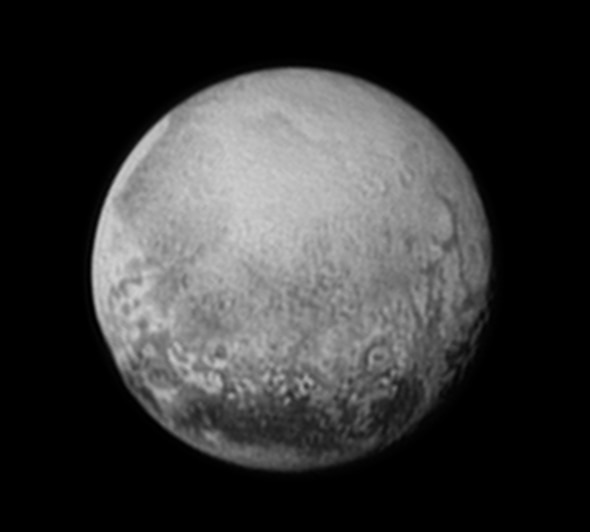Create a free profile to get unlimited access to exclusive videos, sweepstakes, and more!
Pluto Is a Wee Bit Bigger Than We Thought

Update, July 13, 3015 at 20:00 UTC: Emily Lakdawalla has also written about this on her blog, with more details.
Update 2, July 13, 2015 at 20:30 UTC: There has been some confusion about the uncertainties I quote in Pluto's size below. I was using the numbers from wikipedia (the ± 20 km), but I suspect the uncertainty used there is low (see, for example, this article by astronomer Mike Brown). I'm still looking into this, but Emily Lakdawalla in the article linked in the first update says that the new measurements reduce the uncertainty quite a bit, and I'm inclined to agree.
At a press conference on Monday morning, scientists with the New Horizons mission gave updates now that we’re less than a day away from closest encounter.
Two facts stuck out to me: Pluto is a little bit bigger than we thought, and nitrogen is confirmed at its north pole.
Briefly, the latter first: Nitrogen has been detected at Pluto’s north pole, which may explain the bright spot there. On Earth, our poles are shiny due to water freezing there, turning into ice. It’s thought that on Pluto, nitrogen may evaporate from the equator, where it’s warmer, and freezes out at the poles. This new observation supports that. Nifty.
I think the confirmation of nitrogen is scientifically important (if expected), but I bet people will be more surprised to learn that Pluto is slightly bigger than we thought.
The more recent images from New Horizons show that Pluto is 2,370 kilometers ± 20 km across. Previously, it was measured to be 2,368 ± 20 km (some estimates put that diameter a bit lower, too). The size of Pluto is important, because we already know its mass—the time it takes Pluto and its moon Charon to orbit each other give us that, since the orbits depend on the gravity and therefore the masses of the two objects. The size gives us the density, and that in turn gives insight into what Pluto is made of. Ice is less dense, rock more.
This change in Pluto’s size isn’t huge—just 2 km, or 0.1 percent—but it’s significant. It helps nail down Pluto’s density, which is important. What’s perhaps more interesting to many people is what this means about Pluto’s place in the Kuiper Belt, the region of space beyond Neptune loaded with large icy objects.
Eris is another Kuiper Belt object discovered in 2005. It too has a moon (Dysnomia), and that led to a mass measurement showing Eris to be substantially more massive than Pluto, about 1.25 times as massive.
But Eris is very nearly the same size as Pluto! The best measurements we have indicate it’s 2,326 ± 12 km across, similar to but smaller than Pluto. Now that we have Pluto’s size nailed down, we can be even more sure that Pluto is in fact bigger than Eris. Pluto is almost certainly the largest object in the Kuiper Belt.
But it’s not the most massive object! Eris is denser, so it probably has more rock mixed in with its ice.
Even though our knowledge of Pluto’s size only changed a little, I expect this will throw gas on the fire of calling Pluto a planet again. My thoughts on this are clear: The term “planet” is more of a concept than a definition, and Pluto doesn’t care what you call it! We need to study it for what it is, not what we want it to be.
One more thing: As I write this, closest encounter with Pluto is now about 20 hours away. The spacecraft will whiz over the world’s surface just before noon UTC (07:50 EDT) on Tuesday. It will be too busy taking pictures and making measurements to send that info back to us on Earth; later that evening we’ll get the first telemetry telling us if it survived the encounter. So don’t expect a torrent of pictures Tuesday morning!
But Tuesday evening … that’s when the fun begins. Stay tuned.














